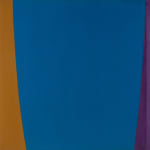William Turnbull 1922-2012
18-1960 (Blue Wedge), 1960
oil on canvas
70 x 70 inches
177.8 x 177.8 cm
177.8 x 177.8 cm
signed;signed and dated verso
Further images
In 18-1960 (Blue Wedge), William Turnbull presents a flatly painted field of blue, which is bounded on its vertical sides by slightly curving bands of yellow ochre and purple, as...
In 18-1960 (Blue Wedge), William Turnbull presents a flatly painted field of blue, which is bounded on its vertical sides by slightly curving bands of yellow ochre and purple, as if the blue had expanded outwards pressing into them. The notion of a swelling shape is present in the slightly earlier painting 14-1960 (Mauve Swell), where a curved mauve shape, suggesting earlier paintings of human heads, presses upwards against bands of blue and black. In Mauve Swell the edges where the colours meet are slightly soft and imperfect; here they are more sharply delineated, the two different tones of purple to the right carefully 'measured out' in order to counterbalance the slightly broader band of ochre to the left.
Turnbull’s strategy of emptying-out the centre of the canvas, and the addition of thin vertical lines to a single-coloured ground, are formal devices he shared with his American contemporary Barnett Newman, whom he came to know and correspond with after being introduced in New York by their mutual patron Donald Blinken. Turnbull’s affinity with Newman and other Abstract Expressionist painters was immediate and was reflected in the commercial success he enjoyed in the USA, showing at the Marlborough-Gerson Gallery, New York, Bennington College, Vermont and the Pavilion Gallery, Balboa, California in the 1960s.
Turnbull’s strategy of emptying-out the centre of the canvas, and the addition of thin vertical lines to a single-coloured ground, are formal devices he shared with his American contemporary Barnett Newman, whom he came to know and correspond with after being introduced in New York by their mutual patron Donald Blinken. Turnbull’s affinity with Newman and other Abstract Expressionist painters was immediate and was reflected in the commercial success he enjoyed in the USA, showing at the Marlborough-Gerson Gallery, New York, Bennington College, Vermont and the Pavilion Gallery, Balboa, California in the 1960s.





